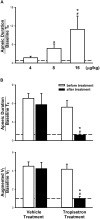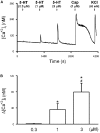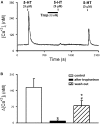Stimulatory Effect of 5-Hydroxytryptamine (5-HT) on Rat Capsaicin-Sensitive Lung Vagal Sensory Neurons via Activation of 5-HT3 Receptors
- PMID: 31191346
- PMCID: PMC6546846
- DOI: 10.3389/fphys.2019.00642
Stimulatory Effect of 5-Hydroxytryptamine (5-HT) on Rat Capsaicin-Sensitive Lung Vagal Sensory Neurons via Activation of 5-HT3 Receptors
Abstract
5-hydroxytryptamine (5-HT) is an inflammatory mediator known to be released in lung. Capsaicin-sensitive lung vagal (CSLV) afferents function as a primary sensor for detecting chemical stimuli and produce consequent reflexes during lung inflammation. To characterize the effect of 5-HT on CSLV afferents, responses of cardiorespiratory reflexes and single-unit C-fiber afferents to right-atrial injections of 5-HT were investigated in anesthetized Sprague-Dawley rats. Bolus injection of 5-HT (8 μg/kg) caused an immediate augmented breath and apnea, accompanied by hypotension and bradycardia. These initial responses were then followed by a brief pressor response and a more sustained depressor response. After a perineural treatment of both cervical vagi with capsaicin to block the conduction of C fibers, 5-HT still triggered the augmented breath, but no longer evoked the apnea, bradycardia and hypotension, indicating an involvement of C-fiber activation. The remaining augmented breath induced by 5-HT after perineural capsaicin treatment was totally eliminated by vagotomy. To further study the effect of 5-HT on CSLV afferents, activities arising from these afferents were determined using the single-fiber recording technique. Right-atrial injection of 5-HT evoked an intense discharge in CSLV afferents in a dose-dependent manner. The highest dose of 5-HT (16 μg/kg) activated 79% (19/24) of CSLV afferents which were also sensitive to capsaicin (0.8 μg/kg). The pretreatment of tropisetron, a selective antagonist of the 5-HT3 receptor, completely blocked CSLV-afferents stimulation induced by 5-HT but did not affect that by capsaicin. Furthermore, a similar afferent response of CSLV afferents was mimicked by phenylbiguanide, a selective agonist of the 5-HT3 receptor. In isolated rat lung vagal C neurons, 5-HT induced intense calcium transients in a dose-dependent manner. The highest concentration (3 μM) of 5-HT activated 67% (18/27) of the CSLV neurons. The 5-HT-induced response was totally abolished by pretreatment of tropisetron. In conclusion, 5-HT exerts an intense stimulatory effect on lung C-fiber terminals mediated through an activation of the 5-HT3 receptor, which may contribute to the airway hypersensitivity under lung inflammation.
Keywords: C-fiber; afferent; airway; inflammation; reflex; serotonin.
Figures








References
-
- Adcock J. J., Birrell M. A., Maher S. A., Bonvini S. J., Dubuis E., Wortley M. A., et al. (2014). Making sense of sensory nerves: an in vivo characterisation of Aδ- and C-Fibres innervating guinea-pig airways. Am. J. Respir. Crit. Care Med. 189:A3969.
-
- Arreola-Ramirez J. L., Alquicira-Mireles J., Morales-Hernandez P. E., Vargas M. H., Villalba-Caloca J., Segura-Medina P. (2015). 5-HT receptor antagonism attenuates the ischemia-reperfusion injury after rabbit lung preservation. Transplant. Proc. 47 1653–1656. 10.1016/j.transproceed.2015.04.089 - DOI - PubMed
-
- Buckner C. K., Liberati N., Dea D., Lengel D., Stinson-Fisher C., Campbell J., et al. (1993). Differential blockade by tachykinin NK1 and NK2 receptor antagonists of bronchoconstriction induced by direct-acting agonists and the indirect-acting mimetics capsaicin, serotonin and 2-methyl-serotonin in the anesthetized guinea pig. J. Pharmacol. Exp. Ther. 267 1168–1175. - PubMed
Grants and funding
LinkOut - more resources
Full Text Sources
Other Literature Sources

